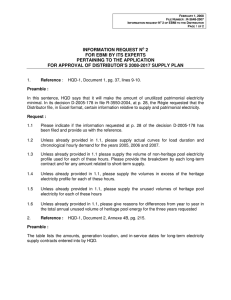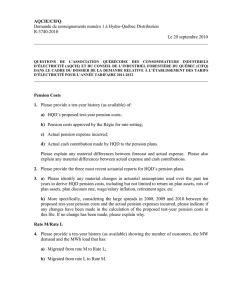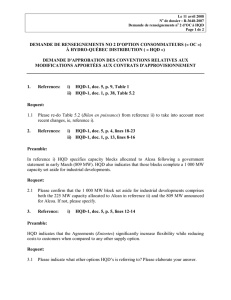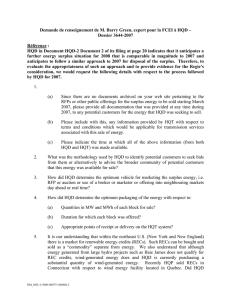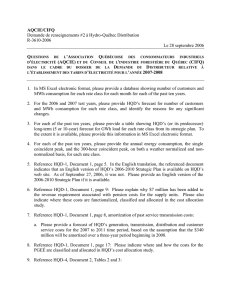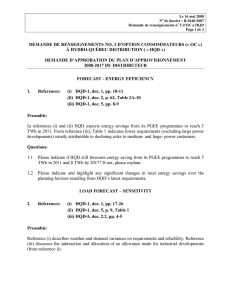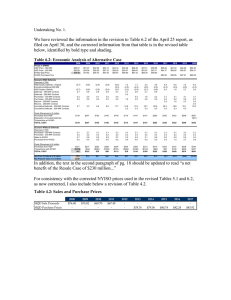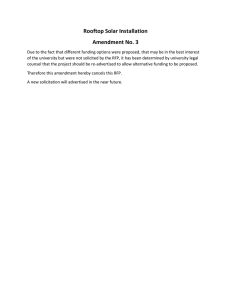Evidence of Barry Green In the Matter of Proceeding R-3644-2007 On behalf of
advertisement
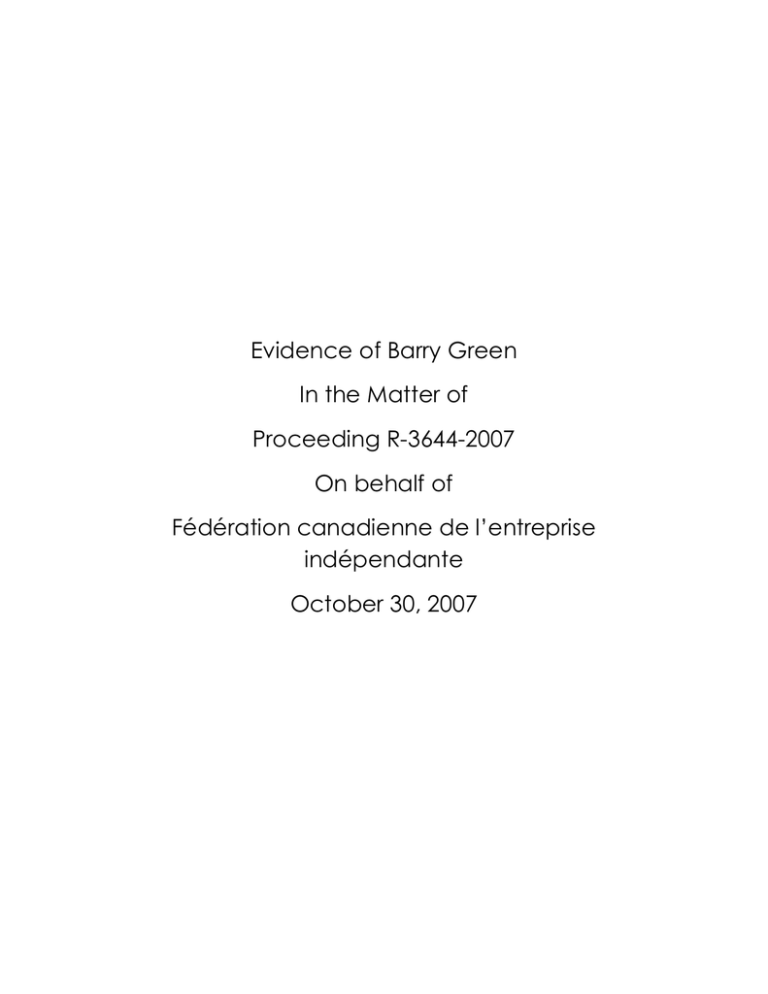
Evidence of Barry Green In the Matter of Proceeding R-3644-2007 On behalf of Fédération canadienne de l’entreprise indépendante October 30, 2007 0 Table of Contents Section 1.0 INTRODUCTION........................................................page 2 Section 2.0 BACKGROUND TO MY EVIDENCE..............................page 3 Section 2.1 The Mechanics of the Sales...................................page 4 Section 2.2 Reaching the Potential Customers........................page 6 Section 2.3 The Design of the Product.....................................page 7 Section 2.3.1 The Degree of Flexibility................................page 8 Section 2.3.2 Timing of Offers.............................................page 8 Section 2.3.3 Size of Energy Blocks Offered for Sale...........page 9 Section 2.3.4 Maximum and Minimum Duration...............page 10 Section 2.3.5 Delivery Points..............................................page 10 Section 2.3.6 Optionality....................................................page 12 Section 2.3.7 Minimum Price.............................................page 14 1 Section 2.3.8 Allocation of Risk..........................................page 14 Section 2.3.9 Other Considerations...................................page 16 Section 3.0 CONCLUSIONS..........................................................page 17 Section 4.0 SUMMARY of CONCLUSIONS....................................page 23 2 1.0 INTRODUCTION: My name is Barry Green. I am President of Barry Green Consulting Inc. Until recently I was employed by Ontario Power Generation (OPG), most recently as the Director of Markets and Research in the Regulatory Affairs Division. I was employed by OPG and its predecessor company, Ontario Hydro, for 34 years. Amongst my duties with OPG was providing advice on regulatory matters to OPG’s staff engaged in trading energy in Ontario and all other jurisdictions. I also filed comments on behalf of OPG in the proceeding R-3624-2007 in front of the Régie de l’énergie in 2007 which led to the market sales by Hydro Québec Distribution (HQD) throughout this year. My mandate, given in this proceeding, is based on the fact that HQD, for the second consecutive year is forecasting that they will have a substantial quantity of surplus energy under contract and are planning to sell it in the marketplace. They will therefore want to optimize these sales in order to maximize the benefit for its customers, the consumers of energy in Québec. I wish to emphasize that any negative comments I might have on the process followed by HQD in 2007 are not offered for the purpose of criticizing past actions by Hydro Québec. I understand that in 2007 they were placed in a situation of needing to dispose of surplus energy very quickly with limited opportunity to study the market. The purpose of my evidence is to provide options, based on HQD’s experience last year and my experience in these matters, that the Company and the Régie may think about as they define the process for 2008 and perhaps other future years. Specifically, I was retained by the Fédération canadienne de l’entreprise indépendante to: 3 1) examine the RFP procedure used by HQD; 2) examine the conditions of the RFP, such as points of delivery and credit requirements; 3) assess the performance of said procedure; 4) draw the appropriate conclusion on the strengths and weaknesses of the operation; 5) identify potential improvements by exposing how such sales are carried out in other jurisdictions; 6) comment on the future of competition and liquidity and propose means that may help HQD obtain the best value for its surpluses. I recognize that in the disposal of surplus energy and more specifically in the issuing and administration of any RFP, there are important considerations to be taken into account, both for the seller, HQD in this instance, and for potential buyers. While in the course of this evidence I will touch briefly on some of the considerations internal to Hydro Québec, my evidence will focus primarily on the external ones, applicable to entities bidding to buy HQD’s surplus. That is, I will be discussing the factors that will be considered by parties contemplating or structuring a bid to buy some of the surplus energy. My recommendations will, for the most part, represent changes that could be implemented in order to make the process more amenable to potential buyers. I believe that all of my recommendations, if implemented, would encourage more entities to participate thus improving the competitive environment and increasing the value that HQD can expect to receive for the energy it is offering. To implement some of these recommendations HQD would have to spend time or money. However, I consider an assessment of the cost and benefits of such expenditures to be beyond the scope of this assignment. 2.0 BACKGROUND TO MY EVIDENCE: 4 Hydro Québec’s evidence is that in 2007, they are anticipating sales by year end of 3.5TWh of surplus energy for which they anticipate gross revenues of $207M. Their evidence also indicates an anticipated surplus in 2008 of 3.9TWh. As a rate-regulated utility, the contract with HQP that is the source of much of this surplus is an asset, previously purchased on behalf of the customers inside Québec. Therefore any revenue that can be realized from the disposition of this energy represents a direct benefit to those customers to be realized in the form of reduced rates for energy sold domestically. In designing a program to dispose of this surplus energy, there are a number of issues to be considered. These include: • The mechanism by which the energy is offered o RFP o Auction o Bilateral Transactions o Sales into neighbouring markets in New England, New York, New Brunswick or Ontario • The means by which potential customers can be reached o Advertising o Access to a list of potential customers o Use of an agent • The design of the product being offered for sale o Degree of flexibility to be offered o Timing of offers o Minimum or maximum size of the blocks of energy o Minimum or maximum duration of the contract o Delivery points including the flexibility in these o Optionality to be offered o Minimum price to be included o Appropriate allocation of risk Section 2 of my evidence will describe how HQD’s surplus sales considered each of these issues with respect to their sales in 2007 and what other alternatives might be pursued in future years. In 5 Section 3, I will offer specific recommendations on how the process might be improved for future years. 2.1 The Mechanics of the Sales During the course of 2007 to date, HQD has issued eight RFPs, one covered the six month period April-September; one covered the two months of July and August, one covered two weeks in September, while the rest were for one month periods of March through October, but not September. Below are the characteristics of the products that HQD was offering the buyer through the RFP: • Purchase of a monthly block of energy (with the exception of the September offer) • 7 x 24 hour firm energy product in every case, a 5 x 16 hour firm energy product starting in July, and an off-peak firm product for July, August and September; • In the multi-month offerings respondents were still expected to make offers for one or more months; • HQD offered to pay liquidated damages for non-delivery except in the event that either party was prevented from fulfilling its obligations as a result of a transmission outage and the parties were unable to agree on an alternative delivery point; • Each product was offered in blocks of 50 MW up to a specified maximum quantity; • Pre-paid transmission to delivery points at NY, New England, New Brunswick or internal to Québec was packaged together with the energy; • Bidders were to offer a fixed price in U.S. dollars; • Successful bidders in some of the RFPs were granted rights to redirect the energy to an alternative delivery point on a day-ahead basis. o In the six month RFP, buyers were able to request the use of an alternative delivery point at least 36 hours in advance. HQD had sole discretion with respect to accepting the request. In making their request buyers 6 were to provide “the amount in $/MWh [by which] HQD shall benefit by agreeing to this change.” o Beginning with the July RFP, the right to redirect was subject to HQDs concurrence and subject to a charge based on one-half the difference between the forward price in the new market and the greater of the contract price or the forward in the original market. • Response times to the RFP varied from 2 days to 7 days but in most cases were 4 days. In all cases offers had to be submitted by a Thursday. Normally the deadline for offers was at 1:00 p.m., although more recently it was at 11:30 a.m. HQD’s evidence is that the energy was available for sale by bilateral contract as well. In response to Question 11.1 from the Régie, they indicate that as much as 25% of their sales in one month (May) were by bilateral contracts. In response to my question no. 3 they indicated that surplus was primarily disposed of by RFPs. 7 2.2 Reaching the Potential Customers In response to question 15.4 from the Régie, HQD indicated a hierarchy of sales strategies stating a preference for the RFP, but for any remaining unsold energy, they considered bilateral transactions or sales to the DAM where these more than recover the costs of deliveries under the cyclable contract. They cite an additional advantage that these bilateral and DAM transactions permit decision-making closer to real time such that they have better information about their needs for domestic supply. In Table R-11-1, in response to interrogatory 11.1 from the Régie, HQD provided information on sales which resulted from the RFPs issued in 2007 as well as bilateral sales and sales in the Day Ahead Markets in neighbouring jurisdictions. In response to question 15.3a, posed by me, they indicated that they had used the services of Emera to gain access to Day Ahead Markets (DAM) in NY and New England. Aside from the benefits to HQD from bilateral sales, there may be benefits to potential wholesale purchasers as well. Varying durations, rather than being offered a monthly product only, might prove attractive. In the same way that the shorter lead time in these transactions can benefit HQD since they have better information about their loads, a reseller would have better information about his resale opportunities. The bilateral market presents an opportunity to ‘customize’ a product to the mutual benefit of buyer and seller, including, for example, a sale over one weekend. These customized products may be valuable in niche markets. In fact, HQD’s evidence in Table R-11-1 is that in two months (June and August) the average price they received from bilateral sales exceeded the average price under the RFP. Who are these potential customers who might be interested in purchasing this electricity that is surplus to the needs of Hydro Québec’s domestic customers? Québec is fortunate, in that it borders four other markets, New York, New England, New 8 Brunswick and Ontario, where electricity is actively traded on an hourly basis. These four markets represent a peak load in excess of 90,000MW. There are 381 registered participants in the market operated by the New York Independent System Operator alone. There are similar, although probably smaller numbers in the other markets and some of the entities operate in more than one of the markets. This represents a great variety of entities, ranging from industrial customers, groups of residential customers, large load serving entities, municipal utilities, generators, electricity marketers and many others. Some would have no interest whatsoever in purchasing Hydro Québec’s surplus electricity, but many others could have a great deal of interest. The question for HQD is how to reach this market. Establishing a “marketing” department involves a considerable investment and not necessarily a prudent one for a company that is not normally a seller of significant quantities of electricity. However, an approach to all customers of TransÉnergie would represent a manageable number of contacts and would serve to spread the word. In addition, in response to my question no. 2 seeking information on HQD’s attempts to “advise the broader community of potential customers that this energy was available for sale” the answer mentioned only advising potential customers of the RFPs. They apparently did not advise potential customers of the availability of energy for bilateral transactions. I have been informed that some of the entities that were participants in the RFP were not aware of additional energy available for sale through bilateral negotiations, apparently on more flexible terms. Greater pursuit of niche markets through bilateral contracts represents an opportunity that may have been under-exploited in 2007. 9 2.3 The Design of the Product I will now talk about this product offering in the context of the bullets I identified in Section 2.0 above and will identify other options that might have been considered in designing the products. My comparison will be to the RFP product as defined, but not possible bilateral products or sales to the DAM. This is a necessary limitation since that is the only defined product for which there is evidence. In addition, the evidence is that this was HQD’s preferred product. 2.3.1 Degree of flexibility Through the RFP process, HQD’s primary channel for sales, they have offered only monthly products, and for most of the period, only a 7 x24 firm energy product. Starting in July they began to offer a 5 x 16 firm energy product and for three months they also introduced an off-peak firm energy product. While these are standard products, readily traded in the market they are only a limited number of products. An off-peak product, either overnight or weekends might have attracted some buyers. A weekly product might have been of value to some customers. A longer term, not just by being able to include multiple months in a single response might have also increased value. HQD seems to have recognized this in the bilateral market, but these were considered secondary marketing channels for this energy. 2.3.2 Timing of offers The timing of the RFPs can be critical for its success. The significant aspects to the timing are the time that it is issued, the time allowed for and the timing of responses. HQD’s timing of the RFPs showed some variability. In each case, the bids had to be filed on a Thursday and, with the exception of the six month offer, this filing date was 3-4 days after posting. In most cases the bids were due on the last Thursday of the month 10 although in two cases the bids were due one or two weeks earlier. In addition, the bids for September and October were due at 11:30 a.m., while all other bids were due at 1:00 p.m. In each case HQD committed to announce the results within one hour. With respect to this timing, there is one other important criterion to be factored into the decision making. Every Thursday morning, the U.S. Energy Information Administration (EIA) publishes information on gas storages. Their web site states that the weekly information will be published as follows: The standard release time and day of the week will be between 10:30 a.m. and 10:40 a.m., Eastern Time (ET) on Thursdays with the following exceptions1. The actual release will occur within 10 minutes of the announced release time. This information can profoundly affect gas futures prices and therefore electricity prices, particularly in New York and New England where the marginal price is frequently based on gas-fired generation. This information can then greatly affect a marketer’s evaluation of the price that they wish to bid for the energy HQD is offering for sale. It would be mutually advantageous to buyers and sellers to delay the deadline for decision making as long as possible such that uncertainties are reduced. Therefore the last Thursday in the month is likely as late as possible that a decision can be made. Since HQD has demonstrated its capability to make its decision in one hour, it should be feasible to leave the filing deadline until 1:00p.m. or even 2:00 p.m. on that day to maximize the time between the publishing of the EIA data and the filing of responses to the RFP. For the buyers, while some of the finalization of their bid will await the EIA data on Thursday morning, it would still be helpful if the RFP were published earlier, perhaps one week in advance of the The exceptions noted on the website, but not cited here, relate to weeks which include holidays. 1 11 response date, providing, if nothing else, assurance to the market that an RFP will indeed be forthcoming. HQD always retains the ability to limit the amount of energy to be awarded in any particular month should information come to light at the last moment that they had little or no surplus for the following month. 2.3.3 Size of Energy Blocks Offered for Sale For all of the RFPs, bidders were asked to bid on one or more blocks of 50 MW each. This is quite a standard block and certainly represents a reasonable minimum size. The types of entities that would be participating in this RFP would be able to manage a 50 MW block and eliminating the option of receiving very small bids would eliminate considerable potential administrative complexity for HQD without significantly affecting prices offered. However, under some scenarios a bidder might prefer to have the option to bid on a larger block. If the bidder has a 75 MW resale opportunity he might want that option. If there is a 100 MW resale opportunity, the bidder might prefer to bid knowing that he will receive 100 or zero rather than having the possibility of winning one 50 MW block and losing the other 50MW. 2.3.4 Minimum or Maximum Duration With just two exceptions, all of the RFPs asked bidders to make offers on a one month block of energy. One exception was the September RFP, closing on September 15th, for the balance of the month. The second was the months of July and August, which were treated together in the March 9th posting the RFP that covered a six month period in total. Within that RFP, bidders were still bidding on one month blocks except for the months of July and August that were packaged together. A one month block of energy represents a very standard package that buyers would be well positioned to handle. If HQD were forced to limit its offers to only one the time period, the monthly block would be the most appropriate. However, this 12 limitation was self-imposed. Offering longer or shorter durations represent opportunities in the market. Under the right circumstances, customers will pay for those opportunities. Therefore a limitation to only a monthly block of energy may underutilize the product that HQD had available for sale. 2.3.5 Delivery Points For any energy transaction not taking place within an organized market, transmission can be one of the most difficult issues to manage and it is in this area where a great deal of the value in this transaction can be added or removed. In all of the offers issued by HQD, they have recognized this reality. As part of its March 9th tendering document, for example, HQD indicates that: HQD will secure Transmission Service on TransEnergie’s system up to the delivery point elected by the bidder. Thus bidders will not be responsible for securing transmission service on TransÉnergie's system nor shall they incur any cost in this respect. While HQD would have incurred a cost to purchase these transmission services from TransÉnergie, it is my opinion that this would have been a worthwhile investment and would have resulted in a substantial increase in the value of the product being offered. One further improvement to the transmission service being offered was the ability, on fairly short notice, to re-direct delivery from one market to another. Given Québec’s strategic location between multiple markets, this optionality could increase the value of the energy to the buyer significantly. However, as discussed below, the value of this feature has been undermined in the RFP. In the original RFP issued on Feb. 27th this feature is not mentioned at all. In the next RFP, the one issued on March 9th covering the six month period, the availability of the right to re-direct is noted as follows: 13 During the term of the Transaction the buyer may from time to time, on a daily basis and at least thirty six (36) hours in advance, request that an alternate delivery point be used by providing the amount in $/MWh HQD shall benefit by agreeing to this change. The acceptance or refusal of such request shall be at HQD’s sole discretion. Following the use of the above clause in the March 9th RFP, subsequent RFP’s do not mention the possibility of redirect until the one issued on June 18th for July and August deliveries. In that RFP and all subsequent ones issued to date, the use of alternate delivery points is described as follows: During the delivery term, the buyer may from time to time, and at least a day in advance, request that an alternate delivery point be used for the reception of the contract energy. If such request is accepted by HQD, the cost associated to the redirection for the relevant period will be established according to the following formula: Redirection cost = [forward price in the market associated with the alternate delivery point − max (contract price ; forward price in the market associated with the initial delivery point)]× ½ The redirection cost cannot be negative (redirection cost ≥ 0 US$/MWh). Compared to the definition in the March RFP, this offer is improved in that the earlier RFP indicated only that HQD expected to be paid for exercising the redelivery option, but did not specify any amount whereas in the June offer a specific formula is defined. However, the work for HQD to accomplish the redirection of the energy is a relatively simple, administrative task. In this RFP, they offer no guarantee that they will permit re-direction, thus allowing themselves full discretion to refuse. In addition, they take on no obligation to identify criteria to justify any refusal and no promise to explain before or after the fact, why they might have refused. They also insist on a substantial proportion of the profit to be gained by carrying out this administrative task, with no risk on their part. As a result, an entity bidding on this energy can assign only limited value to the redirection opportunity that HQD is providing. 14 Alternatively, HQD could offer to provide this service on a “best efforts” basis, which would still carry no absolute obligation on their part. They could reasonably expect compensation in line with carrying out an administrative task in the order of 0.5 to 1 $/MWh. If they did so, I believe they could anticipate that the bids received would be enhanced based on providing reasonable assurance that this additional flexibility would be available for a known price. The delivery point feature of the RFP could be further enhanced if HQD could also offer delivery to, and redelivery to, the Ontario border. I recognize that purchase of delivery capability to Ontario is handled differently, due primarily to the physical differences in the methodology by which transfers occur between Québec and Ontario as compared to transfers between Québec and New Brunswick and between Québec and the U.S. neighbours. This difference is explicitly recognized in the TransÉnergie tariff which requires negotiations with HQP to effect delivery to Ontario. However, if HQD could negotiate appropriate terms in advance, the value of the energy being offered could be further enhanced. 2.3.6 Optionality In preparing to bid in response to an RFP of this type, where the buyer is not an end user but is anticipating reselling the energy in the marketplace, the major consideration is the buyers perceived value for the product. Such perception is affected by characteristics of the product and of the market where the resale is anticipated. However, the presence of optionality, which can provide an ability to re-design aspects of the product as close as possible to the actual time of delivery is highly prized. Many of the characteristics of the package discussed above, such as the redirection option for the transmission service are elements of optionality. 15 From HQD’s point of view, offering optionality could represent some cost in that they will be less certain of what they are selling and how much revenue they will get for the product. The presence of more variations in the product definition will also make the evaluation of the offers more challenging. However, offering optionality, particularly where the cost to HQD might be very small can significantly increase the value to buyers. One way to implement an option would be to offer buyers as part of the monthly RFP, the opportunity to bid both on energy for the next month, and also on an option to buy energy for delivery one month later. For example, under such a design, in the September RFP for October energy delivery, buyers would also be allowed to bid on an option to buy November energy at a fixed price. That is, if successful, they would have the right to buy November energy, but not the obligation to do so at that fixed price. The price could be tied to the then forward price for energy. Prior to the evaluation of the results of the October RFP for Novemeber deliveries, any holder of an option would have to declare that he intends to take delivery of the energy in November at the agreed price or he would give up his rights. By offering this optionality, HQD would be paid the option price and the buyer would get first rights to the November energy at the agreed price. By offering this product, HQD takes on additional load forecast risk since they would be committing one month earlier to make that energy available in November, but they would still be able to control how many option contracts they accept and could be as conservative in doing so as they determine is appropriate. There is also some price risk since they will be fixing the price one month earlier for this block of energy. If the price moves up in the intervening month then they will have sold the energy at below its value, although they will have the option premium to keep as partial compensation. If the price goes down, the holder of the option is unlikely to take delivery and will forego his option premium and bid at the lower price. In 16 this event, HQD will still have made the revenue from the option but will not have to deliver any energy. As discussed in section 2.3.5, the ability to redirect the transmission service is also an option. However, the way it has been offered has meant that it has been reduced in value since the buyer is not really sure it is available and much of the profit but none of the risk has been taken by HQD. 17 2.3.7 Minimum Price HQD did not publish a minimum price as part of their RFP although they clearly would have calculated one for internal use in doing their evaluations. Publishing this minimum price would probably not have significantly altered the dynamics of the RFP process. However, such information might have had some value to the marketplace. It might have eliminated some extraneous bids from being submitted and if a bilateral market were being pursued, it might have assisted participants in that market in making offers to HQD. 2.3.8 Allocation of Risk The purchase and sale of electricity, as with the sale of any other commodity, involves the management of risk. When Hydro Québec purchased this energy in 2002, they assessed their future needs to supply their customers in Québec, assessed the risk of having insufficient energy under contract and the price that they might be charged in the short term market if they needed to access that market to meet customers’ needs and compared that to the price they were being offered in the contract. Based on all of those considerations at the time, they decided that signing the contract was the prudent course of action. Given that in the fullness of time, the energy turns out to have been surplus, their mandate becomes determining how best to package this energy for other wholesale customers, such that Hydro Québec and this different set of customers can best share risk and maximize the benefits of the transaction for both parties. The principal sources of risk to be managed in this sale transaction would be: • Regulatory risk in Québec • Regulatory risk in the neighbouring jurisdiction • Transmission risk in moving the energy out of Québec • Transmission risk in moving the energy into the load jurisdiction 18 • • • • Credit risk Foreign exchange risk Load forecast risk Price forecast risk Given the structure of the RFP, one could determine that the risk has been allocated as follows: • Regulatory risk in Québec has been taken by HQD since buyers have the option to take delivery of the energy at the border • Regulatory risk in the neighbouring jurisdiction has been taken by the buyers • The transmission risk in moving the energy out of Québec has been taken by HQD except if the buyer wants to move the energy into Ontario. It has also been further mitigated by offering the redirection privileges • The transmission risk in moving the energy into the load jurisdiction has been allocated to the buyer • Credit risk must be with HQD as the seller • By calling for bids in U.S. dollars, the foreign exchange risk has been taken by HQD where the market for the ultimate sale is in the U.S. If the buyer were intending to sell in Canada, the buyer would then take on the foreign exchange risk since they are buying in U.S. dollars and selling in Canadian dollars • The risk in HQDs load forecast increasing such that the energy was no longer surplus was with HQD, since to buy back the energy once committed would cost liquidated damages. • The price risk in the neighbouring markets was taken by the buyer. There are some other options that could have been considered in this risk allocation. One is with respect to the transmission risk in moving energy out of Québec. As discussed in Section 2.3.5 HQD has appropriately assumed this risk. However, additional benefit to the transaction could have been achieved, with a concurrent increase in anticipated revenues, if HQD had handled redirection rights differently and added the option of delivery into Ontario. 19 With respect to foreign exchange risk, cross-border sales in U.S. dollars has been the industry standard. However, in this context, HQD and the buyers are likely both very capable of dealing with this risk and some buyers might be better able to deal with a Canadian dollar denominated transaction. Therefore, it may be prudent to allow the buyer to specify the currency of the bid. 20 2.3.9 Other Considerations While all megawatt-hours may be very much alike, sometimes packaging can make a difference. In this context there are two specific aspects of potential packaging of this energy product that appears to have not been considered to date but that might add value in future RFPs. These are the capacity markets in the neighbouring jurisdictions and the renewable energy credit markets (RECs) which exist in many of the neighbouring U.S. states. HQD has offered a firm energy product over a 24 x 7 time frame with liquidated damages. To convert that into a capacity product would incur some risk on HQD’s part as it would limit their ability to recall the energy. However, their evidence is that less than 1% of the energy scheduled for delivery needed to be curtailed. If they were prepared in some months to sell this product as capacity and time the sale such that successful bidders could offer capacity to the neighbouring market, it would enhance the value of the product, and hence the revenue to HQD. A renewable energy credit market also exists in a number of the states bordering Québec. This market allows entities with renewable energy to separately claim a renewable energy credit or REC for each MWh of energy they sell that has been generated from a resource deemed to be renewable. There are different definitions of renewable energy that are emerging and different rules in different markets. In general, energy from large hydroelectric resources such as Baie James is not deemed to be renewable. In general, wind energy is considered renewable. There are some geographical restrictions in this marketplace wherein under some renewable programs, the wind energy for which RECs are being claimed, have to have been generated within a limited number of geographical locations. However, in a recent decision by the Public Service 21 Commission in Massachusetts, wind-derived RECs generated in Québec by HQP have been granted renewable energy credits. Therefore HQD should also be able to take credit for some RECs for its wind-based energy. In many cases, energy and RECs trade separately. That is, an entity generating energy from renewable resources is entitled to bid the energy at one point in time and separately sell the RECs through a bilateral transaction. However, the opportunity exists for HQD to offer a package of RECs based on their purchases of wind power in Québec together with the surplus energy which is the subject of this evidence which could be more attractive than the energy alone. 3.0 CONCLUSIONS: I would commend the Régie’s for its decision in D-2007-13 to have HQD market its surplus energy broadly and not merely to return the energy to HQP. The contract signed by HQP in 2002 represents an asset for the regulated customers of HQD and it was correct that HQD be mandated to optimize the value of that asset for the benefit of native load customers in Québec. In addition, by virtue of this decision, the Régie was signalling that it is interested in developing a market in Québec and this was an important step in that direction. The Régie was expressing confidence that by improving liquidity and by making energy available under reasonable terms and conditions, the market in Québec would be enhanced and wholesale customers would respond to create competition for this surplus and insure a fair price for Québec ratepayers. I would also say that many of the specific elements of HQD’s RFP were well constructed. Particularly given the very difficult timing within which HQD had to publish the initial RFP, they did a credible job and made a number of improvements to the process through the year. However, given that HQD is forecast to be selling similar quantities of energy in 2008 and perhaps beyond, it is prudent to 22 re-evaluate the process and examine all possibilities for improving it. One of the first issues to address in any situation where a party is attempting to sell surplus energy is to insure that as many buyers as possible are aware of the surplus situation and the appropriate manner to make an offer. HQD indicated in their evidence that they had contacted “all its counterparties and other potential counterparties” (translation) to invite them to view the posted RFP on their web site. It is not clear from the evidence who the “other potential counterparties” are and whether this was a sufficiently inclusive list. As noted above, in the NYISO, just one of the four interconnected markets for Québec, there are 381 market participants. While it is likely that a substantial majority of these participants are not potential customers for HQDs surplus, it is evidence that the list of potential customers is large. The evidence also relates only to communicating the sale through the RFP process. There is no indication that the fact that additional quantities would be available through bilateral negotiation was broadly communicated. Since the evidence is that approximately 140 GWh were sold through bilateral contracts in the March through August timeframe, it seems that this information was known to some parties. However, amongst the buyers to whom I spoke, some were unaware that such transactions were being contemplated. The evidence is also that some sales into the DAM were done using an external marketer. There is no evidence as to whether or not the right to act as the marketer on HQDs behalf was granted as a result of a competitive solicitation of some description. In addition, the quantities that were sold in the DAM were very small. Given that HQD had apparently committed to use a marketer, would they have been able to negotiate a better arrangement if certain guarantees were offered. For example would offering guaranteed quantities of energy or certain lead times have made for a better contract for both parties. 23 HQD’s use of RFP’s, bilateral sales, DAM and not scheduling cyclable quantities seems appropriate. One other alternative would be an auction, but I do not think that option offers any substantial advantages over the alternatives which HQD did use and it would involve considerably more administrative complexity. However, partially as a matter of fairness, but more importantly to insure the strongest possible competition, all possible buyers need to be aware of all of the possible vehicles being used by HQD. For example, if parties think that all available energy is being sold through the RFPs, then following a monthly RFP, they would not approach HQD separately for a product that is other than the monthly firm energy product as defined in the RFP. However, it is entirely possible that a negotiated contract might better suit both buyer and seller resulting in a better price for HQD. This seems to have happened in at least June and August where the average price of the bilateral transactions is higher than the average price under the RFP. I would like now to compare selling using the RFPs to selling via bilateral transactions. HQDs stated evidence in response to my question no. 3 and demonstrated in their Table R11-1 indicates a strong preference for the use of RFPs. Of the energy sold in the March through August period approximately 93% of the energy sold was using an RFP, approximately 6% was sold through bilateral negotiations and approximately 1% was sold into the DAM markets. There are certainly advantages to using an RFP. There is an inherent fairness since all bidders have the same information and are purchasing identical products. For this same reason there is minimal administration required to determine the successful bidders. However, bilateral negotiations provide opportunities for both buyers and sellers to attempt to define a product that best matches the needs and wants of both. It may provide for a better offer from a buyer because the product more precisely 24 matches its needs. Instead of a 50 MW block for a month, a 75 MW block for two consecutive weekends or for five consecutive nights in a week or a six week block of 125 MW might precisely match a sales opportunity and a buyer would be willing to offer a better price to lock up both ends of such a transaction. Such a transaction could never happen through the RFP. The fact that in June bilateral prices were 7% higher than RFP prices and in August bilateral prices were 28% higher than RFP prices, albeit on small quantities, illustrates this potential. I would not recommend abandoning the RFP process. It should be retained and would likely continue to be the vehicle for the majority of the sales. However, it appears that to date, the objective has been to sell as much as possible through the RFP and use bilateral transactions as a means of selling the remainder of the surplus. It may instead be prudent to use more of a portfolio approach. If HQD is routinely engaged in bilateral negotiations, then at any point in time they will have a sense of what buyers are interested in and prices they may be willing to pay for specific products. With this information, once RFP bids are known, HQD can make a judgement as to whether or not the RFP price is one for which HQD should sell all of its available surplus or should it instead hold some back for use in bilateral negotiations. Alternatively, based on bilateral negotiations and published index prices, HQP may choose, on some occasions, to commit to some bilateral transactions first and sell the remainder through the RFP. By making use of bilateral transactions, HQD will be able to address many of the shortcomings of the RFP process that I described earlier in this evidence, at least for a portion of the surplus energy. The bilateral process can allow for a better utilization of flexibility in product design (Section 2.3.1) by offering weekend or weeknight or multi-week or multi-month packages. Monthly 50 MW blocks are a well recognized and standard product. Much of the market does trade on this commodity and 25 the RFP’s should continue to utilize this product. However, if some of the available surplus is withheld from the RFP, that portion can be utilized to attempt to attempt to reach niche markets with products of different size (Section 2.3.3) or different duration (Section 2.3.4) where higher prices might be available. This would be particularly true if buyers are aware that the bilateral market is a marketing channel that HQD intends to utilize. As noted above (Section 2.3.2), Thursday morning is when the U.S. EIA posts its gas storage numbers which can significantly influence forward prices in neighbouring U.S. markets where gas is frequently the marginal fuel. Recognizing that it is likely infeasible to delay the bidding deadline beyond the last Thursday of the month, I would recommend that HQD commit to a posting of the RFP on the second last Thursday of the month with a date for responses of the last Thursday of the month and a bid return deadline of 2:00 p.m. Adopting such a schedule will allow bidders to plan as much as possible and the 2:00 p.m. deadline will allow the maximum amount of time for prices to respond to the gas storage information. Optionality, which provides a right but not an obligation, and therefore the ability to retain flexibility as long as possible, is typically something that a buyer will pay for. For example, in purchasing a house, a seller will normally accept a lower price from a buyer willing to provide an offer without any conditions. If the buyer wants to submit a conditional offer, and retain the option to cancel the deal under some conditions, they would normally have to offer more money for that right. Similarly, in these RFPs, buyers were not provided the ability to bid on options. From HQD’s point of view, this would introduce some administrative complexity in evaluating the offers. However, the example discussed in Section 2.3.6, could minimize this complexity and additional risk to HQD, while offering a product buyers might value. 26 Section 2.3.8 above, discussed risk allocation in the RFPs issued earlier this year. I concluded that the risk allocation was, for the most part appropriate. I noted a possible change to deliverability, a recommendation for which is made below. I also recommend a change in the handling of foreign exchange risk wherein buyers be offered the flexibility to bid in Canadian dollars. With respect to credit risk, I am not an expert in this very technical area. I would note however, that there is considerable credit risk in all HQD deliveries. Analogous criteria should be applied in assessing the creditworthiness of the parties to these transactions as with sales to domestic customers. Exporters should not be held to a higher standard. With respect to deliverability, it can be anticipated that for buyers of energy under this RFP, the ultimate market is outside of Québec and therefore, one of the biggest risks would be in accessing the necessary transmission paths out of Québec and into neighbouring market or markets. For that reason, HQD’s decision to secure the transmission path to the borders with New York, New England or New Brunswick was appropriate and likely would have enhanced the value of the product. Similarly, the decision to allow the buyer to re-direct was also a low cost mechanism by which HQD would add further value. However, the decision to charge a significant premium for that service was in my opinion, inappropriate. I would recommend that HQD commit to provide a redelivery option for all energy sold under the RFP on a best efforts basis, therefore still not having an obligation to provide it. This offer should have a fixed price of $1/MWh. HQD should also investigate the feasibility of making arrangements for delivery and redelivery options with Ontario as well. With respect to the opportunity to combine the features of capacity and renewable energy credits with this surplus energy, I would recommend further investigation. I believe the packaging 27 holds some potential for increased value to HQD, but needs further study. However, these features would add considerable complexity to the RFP process and therefore if they are pursued, it should be done through bilateral negotiations with interested parties. 4.0 SUMMARY OF CONCLUSIONS: 4.1 The decision to access the market to resell surplus energy was a good one and should be repeated in future years whenever substantial quantities of surplus energy exist. 4.2 HQD has appropriately advised potential buyers of the RFP process. However, greater “advertising” that surplus energy is available for sale to interested parties through bilateral negotiations should be undertaken. 4.3 An RFP is a good vehicle for selling energy. It is fair and provides for easy evaluation of responses by HQD. However, it should not necessarily be seen as the predominant method. It should be used as a way to move to market standardized blocks of monthly energy. However HQD should be involved in bilateral negotiations as well to explore potential niche markets and nonstandardized products. In many months, it is likely appropriate to withhold some amount of energy from the monthly RFP market for these types of transactions. 4.4 The timing for the monthly RFPs should be standardized. RFPs should be issued on the second last Thursday of the month with bids required by the following Thursday at 2:00 p.m. HQD would make its decision by 3:00 p.m. 4.5 HQD should consider, in consultation with potential buyers, if the value of their surplus energy can be enhanced by offering additional optionality and how best to incorporate this into the RFP process. 28 4.6 I would recommend that buyers in the RFP be offered the flexibility of bidding in U.S. or Canadian dollars. 4.7 I would recommend that the redirection cost be fixed at $1/MWh and the service be offered to buyers on 24 hours notice on a best efforts basis by HQD. 4.8 HQD should investigate the feasibility of including pre-paid Ontario delivery points in the RFP. 29
